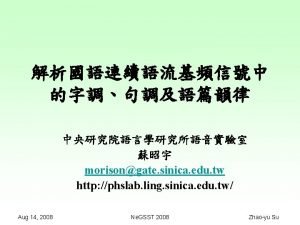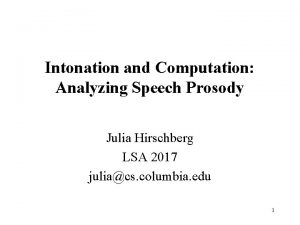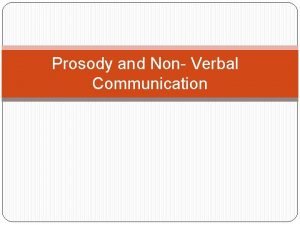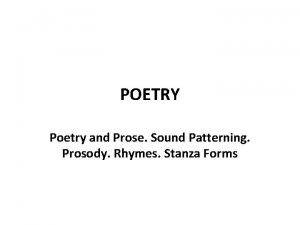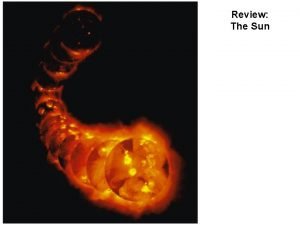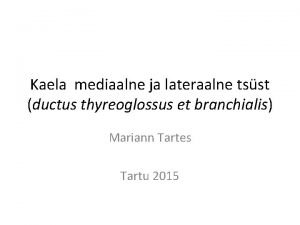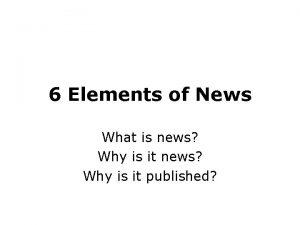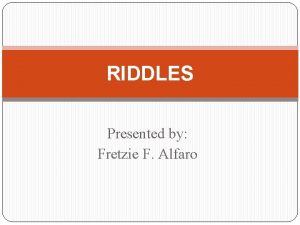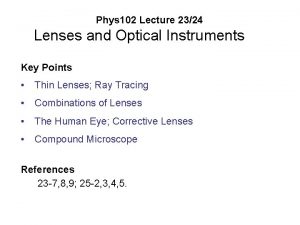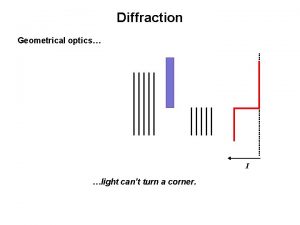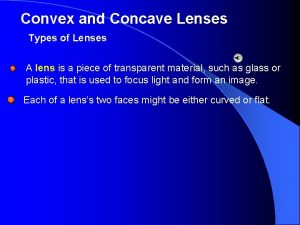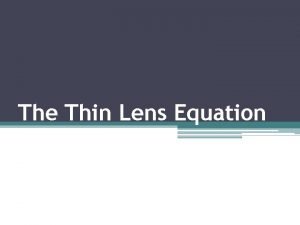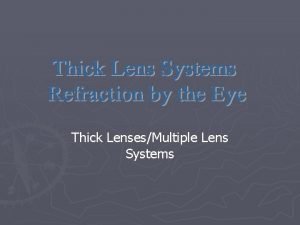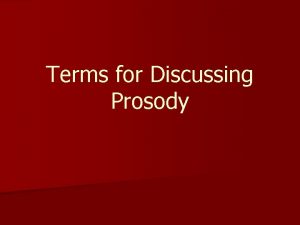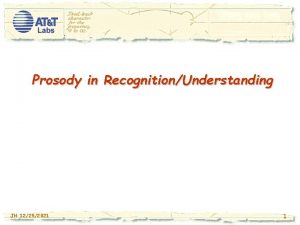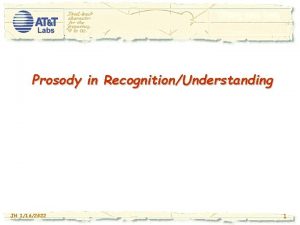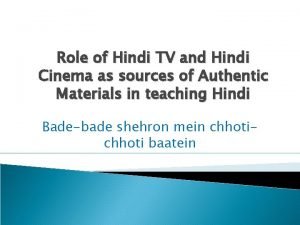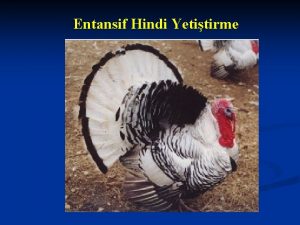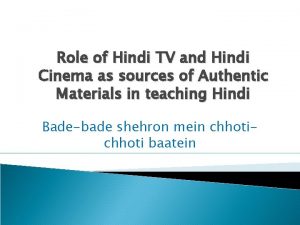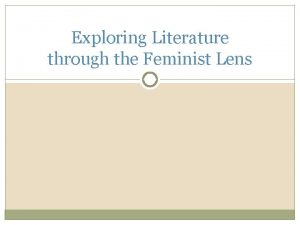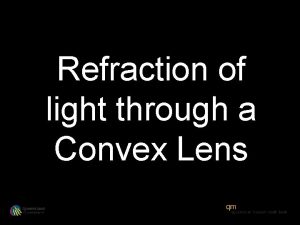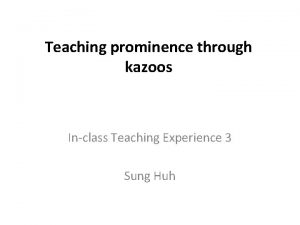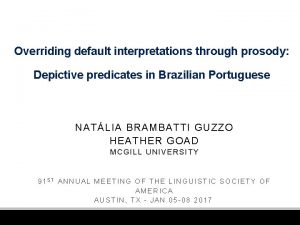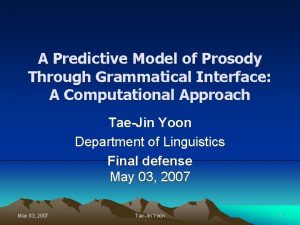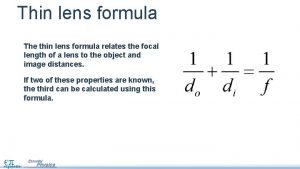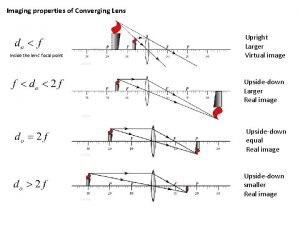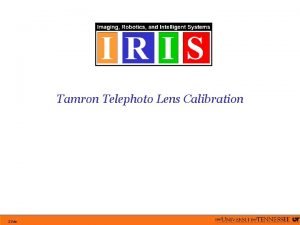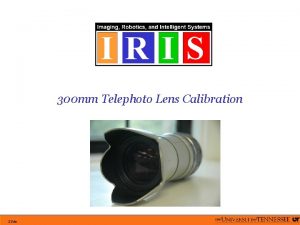HINDI PROSODY through the lens of PROMINENCE theory




















































- Slides: 52

HINDI PROSODY through the lens of PROMINENCE theory Jennifer Cole Northwestern University Funding from NSF BCS 12 51343

The prosody (or intonation) puzzle What is the prosodic system of Hindi/Urdu, and (how) is it different from other languages? How does the prosodic system interface with other levels of linguistic organization? What kinds of meaning are expressed through prosody? 18 June 2018 SALA Konstanz 2

18 June 2018 SALA Konstanz 3

1. Prosodic encoding of information structure: Accent models 2. Prosody & IS in Hindi/Urdu: Focus and Word order 3. Variability in the Prosody-IS mapping 4. IS encoding through Prominence relations-- it’s more 5. Hindi/Urdu in a prominence typology than prosody 18 June 2018 SALA Konstanz 4

Accent models Early work on English… Phrasal accent is assigned to the rightmost stressed word. We saw some good MOVIES. I bought a POODLE. 18 June 2018 SALA Konstanz 5

Accent models Accent marks new information; given information is unaccented. There are MOVIES, and there are good MOVIES. I bought a POODLE, because I’ve always wanted a DOG. Chafe, 1976; Halliday, 1967; Bolinger 1961 18 June 2018 SALA Konstanz 6

Accent models Accent marks new information; given information is unaccented: There are MOVIES, and there are GOOD movies. I bought a POODLE, because I’ve always WANTED a dog. Chafe, 1976; Halliday, 1967; Bolinger 1961 18 June 2018 SALA Konstanz 7

Accent models A later development: Accent type distinguishes focus type H* for informational focus; L+H* for contrastive focus Pierrehumbert & Hirschberg 1990; Ito & Speer 2008 Q: How was the story leaked? Q: Did Jonah leak the story? H* A: Terry phoned the reporter. L+H* A: Terry phoned the reporter. 18 June 2018 SALA Konstanz 8

Accent models Later yet… Prenuclear accent patterns can distinguish focus breadth Prenuclear accent is ok with broad VP focus, but not with narrow Obj focus Selkirk 1995; Breen et al. 2010; Bishop 2017 Q: What did Robert do? Q: What did Robert borrow? A: He [borrowed the SALT]FOC A: He borrowed [the SALT]FOC *He borrowed [the SALT]FOC 18 June 2018 SALA Konstanz 9

Selective vs. non-selective accenting Prosodic encoding of IS in English (& German) depends on: • Selective assignment of pitch accent—a word in any sentence position can be unaccented. • An inventory of distinct accent types—accent type signals IS condition What happens in a language where nearly every word is accented, and which has a single accent melody? Hindi, Spanish, other languages, too! 18 June 2018 SALA Konstanz 10

Hindi/Urdu intonation Hindi/Urdu exhibits a fixed intonational melody (L*H-) assigned to every accentual phrase (= every content word + following function word, in non-focused conditions) kalaam-ne baahar Pooja ke liiye tasviir banaai Puri (2013) 18 June 2018 SALA Konstanz 11

Eliciting IS conditions (Puri, 2013 thesis) • Question prompts determine IS condition of target word. • In this study, the target word is the Object, in pre-verbal position. BROAD FOCUS Q: kja: hʊa: ? A: a: d mi: ne əpni: bi: ʋi: ke lɪje e: k səfed 'sa: bʊn khəri: d a: What happened? The man bought a white soap for his wife. CORRECTIVE FOCUS Q: […] əpni: bi: ʋi: ke lɪje e: k səfed kʊrtɑ: khəri: d a: ? A: nəhĩ […] əpni: bi: ʋi: ke lɪje e: k səfed 'sa: bʊn khəri: d a: Did the man buy a white shirt for his wife? No, the man bought a white SOAP for his wife. POST-FOCUS/ GIVEN Q: […] əpni: biʋi: ke lɪje ka: la: sa: bʊn khərid a: ? A: nəhĩ […] əpni bi: ʋi: ke lɪje e: k səfed 'sa: bʊn khəri: d a: 18 June 2018 Did the man buy a black soap for his wife? No, the man bought a WHITE soap for his wife. SALA Konstanz 12

Findings from some prior studies Study Tested effects of… Main findings… Patil, et al. , 2008 Focus type/Argument: Narrow (Subj. & Obj. ) vs Broad Word order: SOV, OSV Focused word: small effects on f 0 & duration in SFOV Post-focal compression and shortening No effect of focus breadth on pre-verbal constituent Féry, Pandey, Kentner, 2016 Focus type: (results not reported) Argument: Subject, Object Word order (speaker chosen): SOV, OSV Focused word: small effects on f 0, increase intensity in SFOV; no effect on duration Post-focal compression: small effects Genzel & Kügler, Focus type/breadth: Broad vs 2010 Contrastive on Adj in Object NP Focused word: effects on f 0 and duration Puri 2013 Focus/type/breadth: Broad vs Corrective vs Given (Obj. ) Focused word: effects on f 0 (focus type); intensity (focus vs. given); duration (focus type) Jabeen, Bögel, Butt, 2016 [Speech. Prosody] Focus breadth: Contrast-Corrective vs Broad on Verb Word order: SOV, SVO Focus: effect on f 0 rise in SVFO; no effect on duration Word order: different f 0 effects for SOVF vs SVFO, for Verb and Object 18 June 2018 SALA Konstanz 13

Findings from some prior studies** Study Focus Patil, et al. , 2008 Féry, Pandey, Kentner, 2016 Genzel & Kügler, 2010 F 0, duration Puri 2013 F 0, intensity, duration Jabeen, Bögel, Butt, 2016 [Speech. Prosody] F 0 effects, sometimes very small: • increased excursion of f 0 rise on focused word • Compression of post-focal pitch range 18 June 2018 Word order x Focus F 0, duration F 0, intensity, (not duration) SALA Konstanz F 0 of verb, also pre-focus Obj. (not duration) **Statistical models vary, comparisons across studies are qualitative and only suggestive 14

Findings from some prior studies** Study Focus Patil, et al. , 2008 Féry, Pandey, Kentner, 2016 Genzel & Kügler, 2010 F 0, duration Puri 2013 Word order x Focus F 0, duration F 0, intensity, (not duration) F 0, intensity, duration Jabeen, Bögel, Butt, 2016 F 0 of verb, also pre-focus Obj. [Speech. Prosody] (not duration) • When word order and focus are tested together, effects on F 0 are seen in their interaction. **Statistical models vary, • Independent effects of focus on F 0 are found only in comparisons across studies are qualitative and only suggestive studies that don’t examine word order. 18 June 2018 SALA Konstanz 15

Take-home Word order mediates prosodic effects of Focus … to be continued 18 June 2018 SALA Konstanz 16

Variable & vanishing effects of IS on prosody Hindi/Urdu is not special in this regard IS effects on prosody are hard to capture in experimental studies. Let’s take another look at prior work (mostly on English & German)… 18 June 2018 SALA Konstanz 17

Production variability There is a probabilistic association between IS and pitch accent in German and English, Mücke & Grice 2014; Im, Baumann & Cole 2018 and in some cases, no association at all. Chodroff & Cole 2018 Some studies coached or exhorted speakers to produce prosodic distinctions, Breen et al. 2010, Arvaniti & Garding 2007; Liberman & Prince 1984 and still, acoustic prosodic distinctions are often minimal, in laboratory settings. Calhoun 2012 18 June 2018 SALA Konstanz 18

German: Distribution of nuclear pitch accents across IS categories Mücke & Grice, 2014 Given Broad Narrow Contrastive 18 June 2018 SALA Konstanz 19

English: Distribution of prenuclear pitch accents across IS categories Chodroff & Cole, 2018 18 June 2018 SALA Konstanz 20

English: Distribution of pitch accents across IS categories Im, Cole & Baumann, 2018 Referential givenness 18 June 2018 Lexical givenness SALA Konstanz Contrastive focus 21

Perceptual uncertainty IS distinctions are not always accurately identified in metalinguistic forced-choice tasks, even with speech produced by an informed speaker. Roettger & Cole ms. , Breen et al. 2010 In less explicit tasks, listeners’ behavior reveals discrimination. Dahan et al. 2002, Ito & Speer 2008; Frauendorf et al. 2010 Discourse context may influence listener expectations, sometimes overriding acoustic cues. Listener bias may also favor recognition of common IS functions. Bishop 2012; Breen et al. 2010; Roettger & Cole ms 18 June 2018 SALA Konstanz 22

Dialogue pair from the answer-matching task Incongruous Q: Do you know who ripped the ledger? A: Yes, [Mary ripped the ledger]F. [Narrow focus prompt] [Broad focus prosody] Congruous Q: Do you know who ripped the ledger? A: Yes, [Mary] F ripped the ledger. [Narrow focus prompt] [Narrow focus prosody] Mahrt 2018; Roettger & Cole in prep. 18 June 2018 SALA Konstanz 23

Accuracy in choosing prosodic form to match IS condition in Q-A pairs 50% = chance Mahrt 2018; Roettger & Cole in prep. 18 June 2018 SALA Konstanz 24

A prominence-based account If pitch accent type does not reliably signal the IS condition of an expression, what is the relationship between prosody and IS? Prominence: IS distinctions are signaled by the relative prominence of words in an utterance, as reflected in: • Phonetics: pitch height & excursion, duration, intensity, phonation, … • Pitch accent type: rising > high > low Butt, Jabeen & Bögel, Linguistic Analysis. 2016 • Grammatical status: subject > object > verb/predicate • Position in sentence: final > initial 18 June 2018 SALA Konstanz 25

A prominence-based account Beaver & Velleman (2011) Prominence Principle: If one expression is more communicatively significant than another expression, then the first should be more surface prominent than the second. Predictability and focus: An expression's communicative significance is based on a number of different factors. We group these factors into two broad constellations: those having to do with the predictability of the expression, and those which determine whether or not it is focused. Competition for prominence: […] expressions within an intonational phrase will have to compete for primary accent. This competition is what determines how informationally complex material will be realized within an intonational phrase. 18 June 2018 SALA Konstanz 26

A prominence-based account B&V’s Prominence Principle explains the prominence ranking among words in a sentence in English (and German). • Referential: A focused or surprising word must have the strongest phonetic prominence in the sentence. • Structural: peak prominence is perceived at the right edge of a prosodic phrase (=clause) • IS: New > Accessible > Given (cf. , 18 June 2018 Theme > Rheme). SALA Konstanz 27

A prominence-based account Calhoun (2006, 2012) Metrical structure: Theme (topic, background) and Rheme (comment, foreground) are in a (metrical) weak-strong relationship. The theme must be less prominent than the rheme. Prosodic phrase structure: In English, the rightmost prominence is perceived as the strongest, as the structural head of the phrase, so in sentences with rheme-theme order, theme must be phonetically less prominent relative to the rheme. Information structure: Contrastive focus must have the strongest prominence 18 June 2018 SALA Konstanz 28

Evidence from prominence rating studies Comparative studies of prominence ratings for conversational speech Study 1: English, French and Spanish Studies 2 & 3: Hindi (and Russian) Cole, et al. in review Jyothi et al. 2014; Luchkina et al 2015 Preview: Prominence is perceived in relation to acoustic cues, but also in relation to structural and informational properties of words. 18 June 2018 SALA Konstanz 29

Rapid Prosody Transcription Screenshot of web interface for prosodic annotation. Annotator selects a word perceived as prominent (red), and/or a following boundary (vertical bar). Rating is simultaneous with audio presentation. No pitch track or other acoustic display. 18 June 2018 SALA Konstanz 30

Study 1: English, French & Spanish • Annotators rate prominence in three conditions: o Auditory, acoustic criteria o Auditory, communicative criteria o Silent, non-specific criteria • Individual annotator ratings of prominence and boundary are analyzed for each content word in each corpus (avg. 370 words) • Regression models of prominence ratings as predicted from word-level cues, Language and Rating condition 18 June 2018 SALA Konstanz 31

Inter-rater agreement: Prominence 0. 4 0. 35 Fleiss' Kappa English: Agreement is similar for prominence ratings based on explicit acoustic criteria and those defined in terms of communicative importance. 0. 3 0. 25 0. 2 0. 15 0. 1 0. 05 0 English 18 June 2018 SALA Konstanz French Spanish acoustic communicative 32

Inter-rater agreement: Prominence Spanish and French: Agreement is higher for communicative prominence ratings. 0. 4 Fleiss' Kappa 0. 35 0. 3 0. 25 0. 2 0. 15 0. 1 0. 05 0 English 18 June 2018 SALA Konstanz French Spanish acoustic communicative 33

Effects of acoustic cues on prominence ratings 0. 6 Effect size (abs. value) Similar effects of acoustic cues on acoustic prominence ratings in all three languages. 0. 5 0. 4 0. 3 0. 2 0. 1 0 Phonerate English 18 June 2018 SALA Konstanz Intensity French Maximum F 0 Spanish 34

Effects of non-acoustic cues on prominence rating 1 0. 9 Effect size (abs. val. ) Effects of other factors on acoustic prominence ratings are less similar in the three languages. 0. 8 0. 7 0. 6 0. 5 0. 4 0. 3 0. 2 0. 1 0 Word Frequency POS-Adj POS-Adv English 18 June 2018 SALA Konstanz POS-Noun French POS-Vb Boundary Marked Spanish 35

Where these languages differ is whether acoustic and nonacoustic factors have the same influence on acoustic and communicative prominence. (they don’t) 18 June 2018 SALA Konstanz 36

0. 8 0. 7 0. 6 0. 5 0. 4 0. 3 0. 2 0. 1 PO S- Ad PO v SNo un PO SVe rb Bo un da ry Ph on er at e In te ns ity M ax F 0 j Ad S- PO ue nc y 0 Fr eq Differences in the effects of acoustic and non-acoustic factors on prominence ratings are SMALL (red bars) Effect size difference: Acoustic-Commun Effect est. difference In English, communicative prominence (IS) aligns with structural, phonological and phonetic prominence. English 18 June 2018 SALA Konstanz 37

18 June 2018 0. 7 0. 6 0. 5 0. 4 0. 3 0. 2 0. 1 SALA Konstanz French F 0 M ax ity te ns te In Ph on er a ry da un rb Bo Ve un English PO S- No PO S- S- Ad v j PO SAd PO ue nc y 0 Fr eq Differences in the effects of acoustic and non-acoustic factors on prominence ratings are LARGER (blue and gray bars) Effect size difference: Acoustic-Commun Effect est. difference In French and Spanish , communicative prominence aligns with structural prominence, but much less with phonological and phonetic prominence. Spanish 38

How do Hindi (or Urdu) speakers rate prominence? • Like French, which has a similar intonation system? OR • Like Spanish, which has similar word order flexibility? 18 June 2018 SALA Konstanz 39

The prominence model applied to Hindi Prior studies of Hindi/Urdu prosody report effects of focus on acoustic prominence f 0 (all studies) • duration, intensity (some studies) • Are these effects perceived as prominence? What is the influence of Word Order on prominence perception? Hindi Studies 2 & 3: prominence ratings of spontaneous narrative speech, 592 words 18 June 2018 SALA Konstanz 40

Rapid Prosody Transcription Study 2: Hindi acoustic prominence Annotator selects a word perceived as prominent (red), and/or a following boundary (vertical bar). Prominent words are “emphasized or stand out relative to other words in the utterance”. 18 June 2018 SALA Konstanz 41

Inter-rater agreement: Prominence Similar agreement on acoustic prominence ratings for all four languages. 0. 35 0. 3 Fleiss' Kappa Acoustic prominence rating is not dependent on properties of the word-level stress system. 0. 4 0. 25 0. 2 0. 15 0. 1 0. 05 0 English French acoustic 18 June 2018 SALA Konstanz Spanish Hindi communicative 42

Inter-rater agreement: Prominence Notice also agreement with ratings from the silent condition. 0. 4 0. 35 Fleiss' Kappa 0. 3 0. 25 0. 2 0. 15 0. 1 0. 05 0 English French acoustic 18 June 2018 SALA Konstanz Spanish communicative Hindi silent 43

Inter-rater agreement: Prominence Lexico-syntactic prominence is highly salient. 0. 4 0. 35 0. 3 Fleiss' Kappa Only for Hindi: agreement is similar for prominence ratings under all conditions. 0. 25 0. 2 0. 15 0. 1 0. 05 0 English French acoustic 18 June 2018 SALA Konstanz Spanish communicative Hindi silent 44

Study 3: Hindi communicative / attentional prominence Prominence rating of same speech samples used in Study 2, but with modified protocol. • Auditory presentation without text • Text presentation followed auditory presentation, and participants were instructed to mark every word that was “the focus of your attention”. 18 June 2018 SALA Konstanz 45

Inter-rater agreement: Prominence 0. 4 0. 35 0. 3 Fleiss' Kappa Hindi and English show similar agreement between acoustic and communicative prominence ratings. 0. 25 0. 2 0. 15 0. 1 0. 05 0 English French acoustic 18 June 2018 SALA Konstanz Spanish communicative Hindi silent 46

Study 3: Hindi communicative / attentional prominence Linear regression modeled variation in average prominence ratings by • Presence of emphatic marker hii • Position: pre-verbal vs. ex-situ (2% of clauses had postposed or preposed arguments) • Lexical & Referential givenness (Baumann & Riester 2012, 2013) • Acoustic measures: intensity, f 0 max & range, duration 18 June 2018 SALA Konstanz 47

Study 3: Hindi communicative / attentional prominence Factors that significantly boosted avg. prominence: • emphatic marker hii • pre-verbal, post-posed • Referentially new words and proper nouns • intensity, f 0 max (not duration) Unexpected effect: lexically new words had lower prominence than lexically given words. Repeated lexical mention may be a strategy for emphasis. 18 June 2018 SALA Konstanz 48

Study 3: Hindi communicative / attentional prominence Factors that significantly boosted avg. prominence: • emphatic marker hii • pre-verbal, post-posed • Ref. -new & lex. -given words, proper nouns IS prominence • intensity, f 0 max (not duration) 18 June 2018 Lexico-syntactic prominence SALA Konstanz Acoustic prominence 49

Study 3: Hindi communicative / attentional prominence Factors that significantly boosted avg. prominence: • emphatic marker hii • pre-verbal, post-posed • Ref. -new & lex. -given words, proper nouns IS prominence • intensity, f 0 max (not duration) Lexico-syntactic prominence Acoustic prominence In Hindi, lexical, structural, and acoustic prominence align with IS prominence, as attentional foci. 18 June 2018 SALA Konstanz 50

Summing up • Conflicting evidence for IS effects on intonation, resolved under a Prominence model. • The Prominence Principle requires alignment of communicative prominence with “surface” prominence: lexical, syntactic, phonological, phonetic • Perceptual prominence ratings support the Prominence model in Hindi, which predicts the observed interaction of word order and focus on acoustic prominence. • Evidence for prominence alignment requires richly varying and expressive speech materials -- a methodological challenge! 18 June 2018 SALA Konstanz 51

What we’re doing now… • New study comparing Hindi & Russian: Prominence rating with longer, intact narratives • more ex-situ word order • add animacy, grammatical status to model • Luchkina, Rimzhim, Puri & Cole • Study examining how speaker affect competes with linguistic prominence for prosodic expression in American English. Im, Cole & Baumann Speech Prosody 2018 18 June 2018 SALA Konstanz 52
 Speech prosody
Speech prosody Speech prosody
Speech prosody Verbal prosody
Verbal prosody Prosody in asl
Prosody in asl Terza rima structure
Terza rima structure Pharyngeal arches
Pharyngeal arches A solar prominence from soho
A solar prominence from soho Ductus thyreoglossus
Ductus thyreoglossus 8 values of news
8 values of news Example of timeliness news
Example of timeliness news Prominence news example
Prominence news example Yamang napapalitan
Yamang napapalitan Baboy sa lasang, ang tunok puro lansang
Baboy sa lasang, ang tunok puro lansang Efrous
Efrous Lens equation
Lens equation Fresnel and fraunhofer difference
Fresnel and fraunhofer difference Concave lens
Concave lens Lens equations
Lens equations Architypal
Architypal Thick lens theory
Thick lens theory Through one man sin entered the world, and through one man
Through one man sin entered the world, and through one man Class 2 furcation
Class 2 furcation Advantage of through and through sawing
Advantage of through and through sawing Night of scorpion poem
Night of scorpion poem Hình ảnh bộ gõ cơ thể búng tay
Hình ảnh bộ gõ cơ thể búng tay Bổ thể
Bổ thể Tỉ lệ cơ thể trẻ em
Tỉ lệ cơ thể trẻ em Gấu đi như thế nào
Gấu đi như thế nào Chụp tư thế worms-breton
Chụp tư thế worms-breton Chúa sống lại
Chúa sống lại Môn thể thao bắt đầu bằng chữ đua
Môn thể thao bắt đầu bằng chữ đua Thế nào là hệ số cao nhất
Thế nào là hệ số cao nhất Các châu lục và đại dương trên thế giới
Các châu lục và đại dương trên thế giới Cong thức tính động năng
Cong thức tính động năng Trời xanh đây là của chúng ta thể thơ
Trời xanh đây là của chúng ta thể thơ Cách giải mật thư tọa độ
Cách giải mật thư tọa độ Phép trừ bù
Phép trừ bù độ dài liên kết
độ dài liên kết Các châu lục và đại dương trên thế giới
Các châu lục và đại dương trên thế giới Thơ thất ngôn tứ tuyệt đường luật
Thơ thất ngôn tứ tuyệt đường luật Quá trình desamine hóa có thể tạo ra
Quá trình desamine hóa có thể tạo ra Một số thể thơ truyền thống
Một số thể thơ truyền thống Cái miệng nó xinh thế
Cái miệng nó xinh thế Vẽ hình chiếu vuông góc của vật thể sau
Vẽ hình chiếu vuông góc của vật thể sau Thế nào là sự mỏi cơ
Thế nào là sự mỏi cơ đặc điểm cơ thể của người tối cổ
đặc điểm cơ thể của người tối cổ Thế nào là giọng cùng tên? *
Thế nào là giọng cùng tên? * Vẽ hình chiếu đứng bằng cạnh của vật thể
Vẽ hình chiếu đứng bằng cạnh của vật thể Phối cảnh
Phối cảnh Thẻ vin
Thẻ vin đại từ thay thế
đại từ thay thế điện thế nghỉ
điện thế nghỉ
